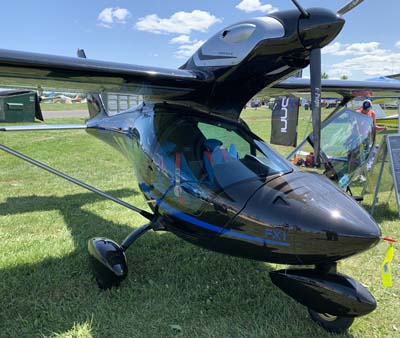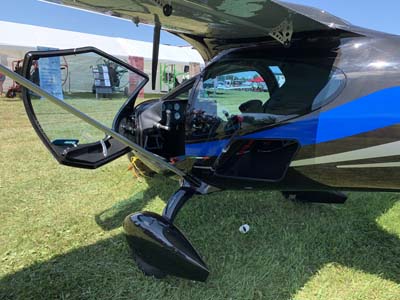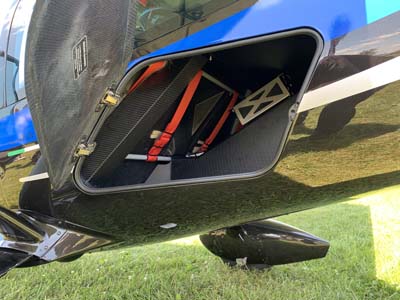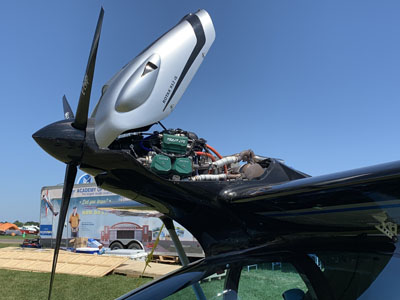 After impressing European pilots at the big German show called Aero Friedrichshafen, producer InnovAviation brought their sleek and sexy FX1 for Americans to see at Oshkosh 2019. For American representation, the Italian producer will be teaming up with Deon Lombard, who also represents the AeroPilot L600 from a Czech manufacturer.
After impressing European pilots at the big German show called Aero Friedrichshafen, producer InnovAviation brought their sleek and sexy FX1 for Americans to see at Oshkosh 2019. For American representation, the Italian producer will be teaming up with Deon Lombard, who also represents the AeroPilot L600 from a Czech manufacturer.
 I can’t imagine how anyone can look at Alfredo Di Cesare‘s creation and not react with admiration. Italian companies are known for dashing and innovative lines (think: Ferrari or any number of auto companies or LSA giant, Tecnam). Design talent is definitely not lacking from Italian products; FX1 should be an object of national pride.
I can’t imagine how anyone can look at Alfredo Di Cesare‘s creation and not react with admiration. Italian companies are known for dashing and innovative lines (think: Ferrari or any number of auto companies or LSA giant, Tecnam). Design talent is definitely not lacking from Italian products; FX1 should be an object of national pride.
The FX1 is an evolved fourth-generation aircraft following the JetFox 97 from the 1990s. Designed by Alfredo Di Cesare, a noted aircraft designer with over 35 years of experience in the sport-plane industry, FX1 is clearly related to the earlier model but it is so different in many ways that it is unfair to compare them directly.
InnovAviation was founded in 2001 by Alfredo after he operating in the early 1980s as an importer and kit builder of the American Striplin Aircaft. A few years later in 1988 he became the importer for the Comco Ikarus C22, one of Germany’s most popular light sport planes.
In 1991 Di Cesare designed, built JetFox 91, with close to 160 units sold. Most are still flying, the company indicated. Six years later in 1997, Di Cesare introduced a redesigned JetFox 97 and close to 180 units were produced by Alfredo’s company, Euroala. In 2005, an upgraded version JetFox GT was introduced. An amphibian prototype was exhibited in 2006.
Then Arrived FX1
FX1 is Alfredo’s latest and best design. “It features a totally new airframe that incorporates numerous improvements and refinements using state-of-the-art methods and materials,” said InnovAviation. “FX1 is a high-performance sport plane that reflects Alfredo’s great sense of style, his attention to detail, and his high standards for airworthiness and safety.”

FX1 is a welded steel structure with a carbon fiber skin. During an Oshkosh video interview we learned the carbon fiber skin can be completely removed in about one and half hours when, for example, you may need to do a very thorough inspection.
Some aircraft that evolved from similar design can have rather awkward engine mounts, commonly with exposed engines. While I see nothing wrong with that — and they are certainly easy to inspect and maintain — Alfredo’s has smoothly encased the fuel injected Rotax 912iS in… you guessed it, more carbon fiber.
Wings and control surfaces are riveted aluminum, which can be repaired as needed by airplane mechanics almost anywhere in the world.

In the side-by-side seats, FX1 features handsome side sticks on the outside of each seat. A single throttle is center mounted. All controls are within an easy reach.
Visibility is enormous, with occupants surrounded by perhaps 300 degrees of clear acrylic. The Rotax engine above and in front of the cockpit is almost out of sight and only very marginally impedes your vision, less so than most engines on the nose of an aircraft.
“FX1 delivers ease of flying, comfort, safety, ruggedness, durability, attractive styling and exceptional performance across the board,” boasted the company. For more, check our report after Aero 2018 last year, which also has our video interview from that show.
In the USA, FX1 is represented by Fly Light Sport CA, with operations in Fullerton California and Fort Pierce, Florida.
InnovAviation FX1 Specifications
- Cabin width — 49 inches
- Wing Span 27 feet 7 inches
- Wing Area — 122.7 square feet
- Empty Weight — 728 pounds
- Max Takeoff Weight — 1,320 pounds
- Useful Load — 592 pounds
- Payload (full fuel) — 407 pounds
- Baggage Allowance — 77 pounds
- Fuel Capacity — 30.9 gallons
- Maximum Continuous Speed — 136 mph / 120 knots
- Cruise Speed (75% power) — 124 mph / 108 knots
- Stall Speed (flaps down — 40 mph / 35 knots
- Never Exceed Speed — 150 mph / 130 knots
- Range — 645 nautical miles
- Endurance at Cruise — 5.5 hours



First of all, Alfredo offers 600kg MTOW. This is fabulous! Second, there are by far more reliable and modern engines than the old Rotax brands. Third: If one wants to use the bird for many other performances the location of the engine is optimum. MT-GE
Hi Manfredi: We hear your enthusiasm about FX1, but wonder to which engine you refer regarding Rotax brand being less reliable. Most pilots give glowing reports about Rotax’s 9-series engines.
Are you stupid. Rotax is the best !!!
That is a sexy beast and looks easy to get in and out of as well.
“I can’t imagine how anyone can look at Alfredo Di Cesare‘s creation and not react with admiration”
My first though – OMG it’s going to nose right into the pavement when you need to go around.
Maybe they engineered a way around it, but to me it looks [dangerous to me]. 🙂
Hi Lorne: Engines in this position are not uncommon in aviation and a good designer can work around the issues you envision.
The age old problem of where to put the engine and pilot!
Electric can open new possibilities. You can see our hybrid onboard charging system behind the drone tent at Innovations.
Congratulations Alfredo !
Amazing. ..
Beautiful airplane…once licensed and FAA approved could greatly serve in flight schools for Private and LSA certificates.
There is a potential issue with that high mounted engine, the thrust line is high, and with an engine failure the nose will pitch up perhaps higher than you would like. On take off you would have to have your engine out procedures well sorted out.
High mounting engine is very good. This aircraft would never drop the nose while stalling, just lose height like a helicopter.